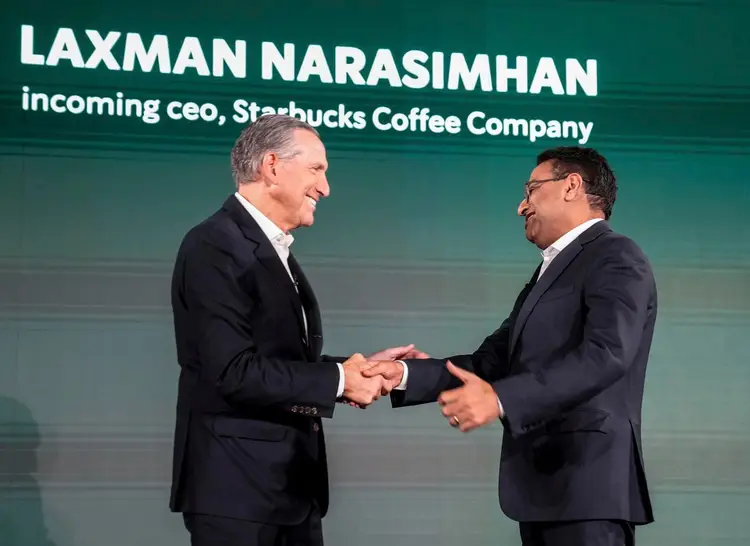Starbucks' CEO's Efforts to Cultivate Employee Trust through New Strategies

At the Starbucks Investor Day 2022, Howard Schultz, who is currently serving as the Interim CEO, greeted the newly appointed CEO, Laxman Narasimhan with warmth and cordiality. This momentous occasion marked the beginning of a new chapter in the history of the coffee giant.
Last October, Laxman Narasimhan, the new CEO of Starbucks, made a purposeful decision about where to allocate his focus.
Narasimhan put on a green apron with the logo of the company and started taking a 40-hour training course to become a certified barista at Starbucks. In March, when he took on the role of CEO, Narasimhan made it clear that he would keep working as a barista for four hours a month at different Starbucks stores. He also stressed the importance of his senior executives doing the same thing.
The way a new CEO or leader spends their time can reveal their main concerns and goals. Usually, newly appointed CEOs of public companies would prioritize meeting with investors, working closely with the Board of Directors, and holding discussions with Wall Street analysts. It's unusual for the CEO to spend an entire week attending frontline staff training sessions.
Maybe it's worth considering because there are real benefits when a leader fully involves themselves in the daily lives of employees who work directly with customers:
Initially, this act clearly communicates a message to the employees. It does not refer to a leader conducting several employee-focused sessions after visiting several cities (although this approach can also be helpful). Instead, it refers to the leader utilizing significant time (like Narasimhan who used an entire workweek) to learn the crucial skills related to their business.
No matter if it's a week filled with extensive training or simply observing frontline staff, the result is identical. The employees witness a leader who dedicates their time to grasp the complexities of the business, empathize with frontline workers, and gain insight into what it truly means to cater to customers. This type of invested and knowledgeable leader is more likely to have a following among the workforce.
Furthermore, it cultivates a culture that prioritizes customer satisfaction and teamwork. When bosses actively participate in the day-to-day operations, such as Narasimhan brewing cappuccinos for customers at the drive-thru or a CEO of a financial services company answering customer calls, these seemingly small actions can have a powerful impact on the company culture.
These are actions that emphasize how crucial it is for everyone to focus on the needs of the customer. They aid in breaking down strict organizational structures by demonstrating to the staff that no task is insignificant. It shows that every worker, no matter their position, plays a part in serving the customer. These actions encourage a strong sense of unity among the team, bringing people together under a leader who is approachable rather than distant.
Additionally, it presents chances to enhance the customer and employee satisfaction. The involvement of a top-level executive in the shoes of a frontline employee is invaluable to observe the obstacles they face when trying to serve customers. These difficulties could include outdated systems, unclear protocol, excessive rules, unsatisfactory job requirements, complicated products, or any other hindrance. As an instance, Narasimhan noticed the challenges that the Starbucks baristas faced in matching cups and lids. As a result, he is now making efforts to streamline the process.
Managers could come across these challenges from reading a report or listening to their employees, but it's not until you witness them firsthand and feel the resulting irritation that you truly understand their impact. This exercise generates empathy and a sense of urgency, compelling leaders to establish a workplace that frees their team from such barriers.
Leaders have one of the most important assets at their disposal, which is their time. Unfortunately, when they contemplate maximizing its usage, they often only consider reducing their schedule. This involves setting aside more time for introspection, appointing representatives to attend meetings on their behalf, and reallocating responsibilities to their subordinates.
However, exchanging that currency, and utilizing it to further involve the employees, is often more effective by including more tasks in your routine, just like how Laxman Narasimhan attended barista training (and still does by filling in as a barista once a month).
It's advisable for every leader to take a cue from Narasimhan and understand that gaining the trust of employees takes more than just sitting in their comfortable office. To establish trust, it's necessary to empathize with the employees, view things from their point of view, and demonstrate your commitment to their success.
Author Jon Picoult wrote a book titled "FROM IMPRESSED TO OBSESSED: 12 Principles for Turning Customers and Employees into Lifelong Fans". You can receive his monthly eNewsletter about Customer Experience & Leadership by subscribing through the link provided.











































